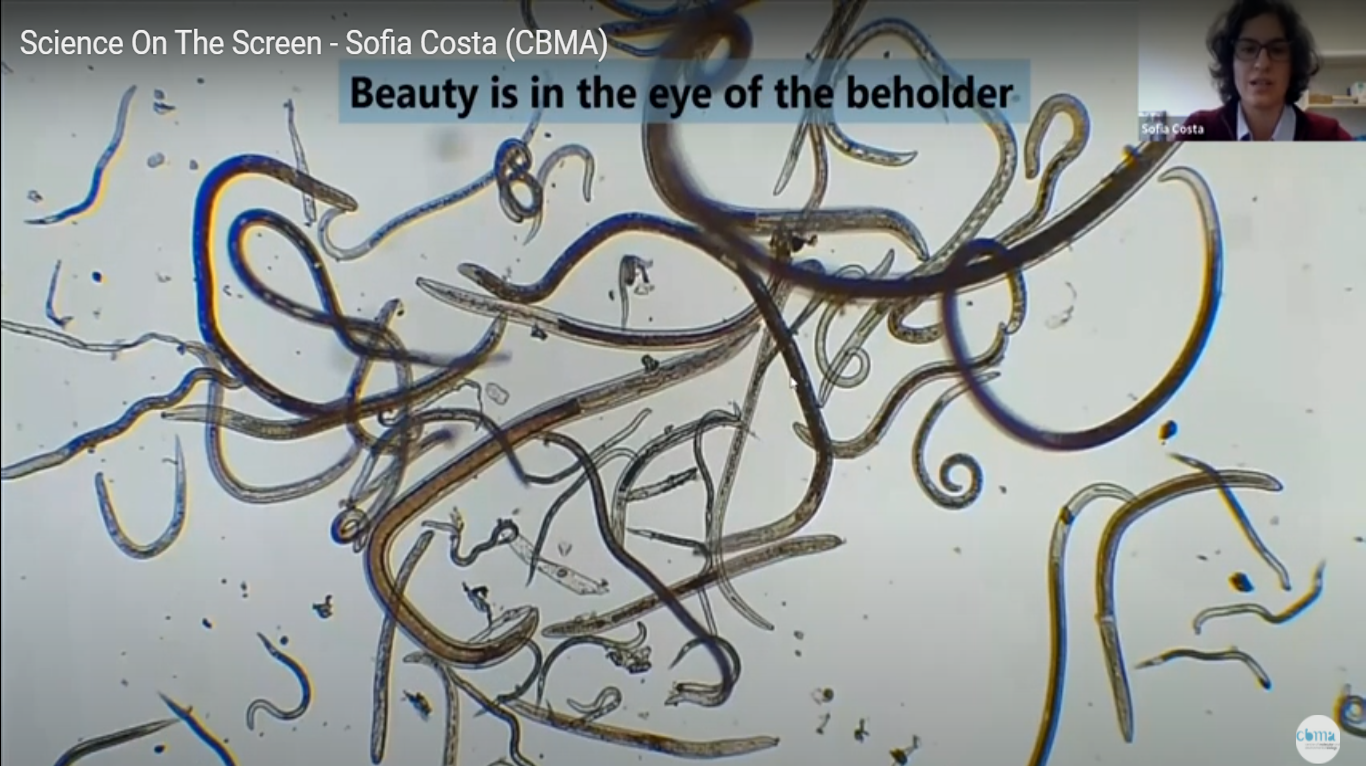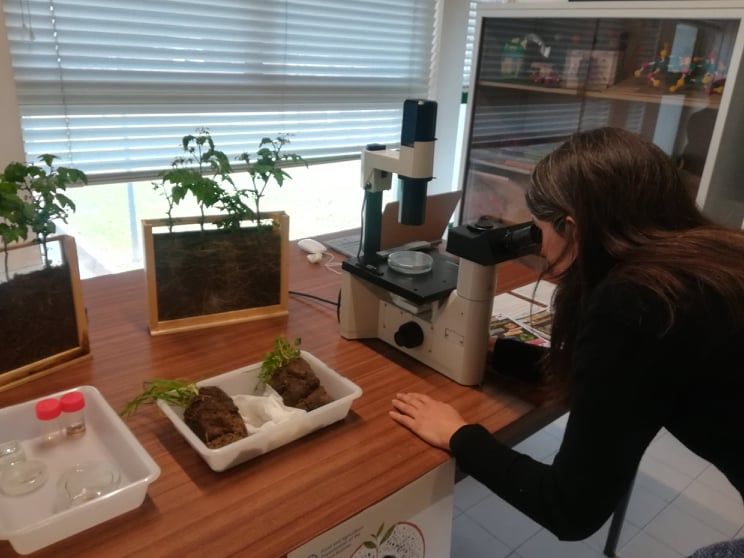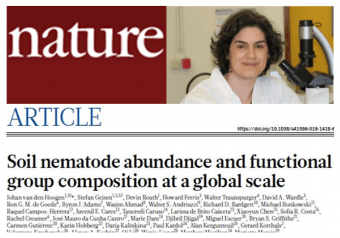Layout do blog
New paper: Interaction of symbiotic rhizobia and parasitic root-knot nematodes in legume roots – from molecular regulation to field application
Project Handler • jan. 25, 2021
https://doi.org/10.1094/MPMI-12-20-0350-FI
This comprehensive review examines the molecular control of legume interactions with symbiotic rhizobia (that induce formation of nitrogen-fixing nodules) and root knot nematodes (that induce the formation of galls) to elucidate shared and distinct mechanisms of these root microbe interactions. Studies on root-microbe interactions are crucial for future crop management and breeding strategies.

Por Project Handler
•
27 abr., 2021
Check out Sofia Costa’s presentation on using nematodes as bioindicators to address how ‘Soil functioning relates to land use in a sustainably managed agro-sylvo-pastoral ecosystem’: 3_Costa_Sofia_ID130.pdf . Recording of the session available here: https://www.youtube.com/watch?v=1xCrARXfdHM

Por Project Handler
•
11 nov., 2020
Nematodes: the good, the bad and the ugly – Science on the Screen by Sofia Costa. Follow the link to watch the full online seminar held on the 9th November 2020. The key roles of soil nematodes in ecosystem regulation and influence on plant performance were highlighted and an overview of the research carried out by our nematology group at CBMA on soil nematode ecology and how it can be exploited to promote sustainable management of plant-parasitic nematodes in agroecosystems, was presented.

Por Project Handler
•
06 nov., 2020
Next Monday Sofia Costa (CBMA, University of Minho), will be presenting "Nematodes: the good, the bad and the ugly” on Science on the Screen, the Online Seminar Cycle of the Biology Department, University of Minho in which invited scientists talk about science and let us know about their research work, in about 30 minutes: Summary Nematodes are simple, microscopic animals that occupy all ecological niches where moisture and a carbon source are available. Although they are often overlooked, they are the most abundant and diverse animals on Earth, and their sheer numbers and metabolism make them relevant to ecosystems in all functions they perform. Soil nematodes are mostly beneficial organisms, involved in ecosystem regulation and nutrient mineralisation, but herbivory can be a major disservice, especially in agroecosystems, where they cause significant losses. Complex assemblages can build up in rhizosphere soil, where nematodes interact and communicate with several organisms (bacteria, fungi and plants), with important outcomes for plant performance. Here, an overview of the research on soil nematode ecology and how it can be exploited to promote sustainable management of plant-parasitic nematodes in agroecosystems, carried out by our nematology group at CBMA, is presented.

Por Project Handler
•
23 set., 2020
Root-knot nematodes are not only damaging to horticultural crops – in our paper in the Journal of Nematology, we have identified Meloidogyne naasi , previously unreported in the Iberian Peninsula, from poorly-performing turfgrass in a football field. The high maintenance sports turf turned out to be a complex ecosystem, containing not only root-knot nematodes but also their microbial enemies. We also report wormstars, a kind of aggregation previously undetected in plant-parasitic nematodes, putatively caused by a nematode pathogen.

Por Project Handler
•
14 jul., 2020
A recent article in Frontiers in Plant Science authored by Sofia Costa (CBMA, UMinho), Sabrina Chin and Ulrike Mathesius (Australian National University) reports on what plant biochemical pathways allow infection and gall formation by root-knot nematodes Meloidogyne javanica . Nematodes have putatively obtained genes from friendly nitrogen-fixing bacteria (rhizobia) that allow them to manipulate the plant biochemical pathways and induce the formation of root galls, that share some structural similarities with rhizobial nodules. But, results revealed that genes essential for rhizobial nodulation are not involved in nematode induced gall formation, and further hint at the involvement of ethylene signalling in nematode infection and establishment of a feeding site.

Por Project Handler
•
06 abr., 2020
CBMA celebrates World Soil Day (December 5th) with the public exhibition “O solo não é só terra” (EN “Soil is not just land”), that aims to educate and raise awareness about the importance of soil in human life. The initiative allows you to touch and see the diversity of soil organisms. It is also possible to observe, through the transparent Rhizotron structure, live plant roots in its soil and analyze the different surface horizons of the soil through soil cylinders. This exhibition pays particular attention to CBMA’s nematodes research, the most abundant and diverse microscopic animals on the planet and which have many functions in key processes in terrestrial ecosystems. The activity of these animals helps to determine the proportion of carbon captured in organic matter and soil organisms in addition to what is emitted as carbon dioxide, which makes them bioindicators. CBMA has ongoing research projects on soil functioning, funded by the Foundation for Science and Technology, such as HANDLER and TREND, and has recently collaborated on a publication on nematodes in the reputed journal Nature. (https://cbma.uminho.pt/world-soil-day/)

Por Project Handler
•
10 set., 2019
CBMA researcher Sofia Costa is co-author of the first global analysis of world’s most abundant creatures plublished in the journal Nature. This study is the first to map the global distribution of soil nematodes, tiny creatures also known as roundworms. They make up an estimated four fifths of all terrestrial animals and play a critical role in soil nutrient cycling, plant growth and the climate. The study reveals that the majority of the world’s animals live in high latitudes: 38.7% of soil nematodes exist in boreal forests and tundra across North America, Scandinavia and Russia; 24.5% in temperate regions; and only 20.5% in the tropics and sub-tropics. It also calculates that the world’s population of soil nematodes is far greater than previously estimated, with 57 billion for every single human. They have a total biomass of around 300 million tonnes – approximately 80% of the combined weight of Earth’s human population of 7.7 billion people.

Por Project Handler
•
09 set., 2019
A Noite Europeia dos Investigadores — European Researchers’ Night — é uma iniciativa lançada em 2005, atualmente bianual, financiada pela Comissão Europeia, no âmbito das Ações Marie Curie, com o objetivo de celebrar a Ciência e de aproximar investigadores e cidadãos.
Siga-Nos!
Este trabalho é financiado por fundos nacionais através da FCT – Fundação para a Ciência e a Tecnologia, I.P., e co-financiado por fundos europeus do FEDER (Fundo Europeu de Desenvolvimento Regional) através do programa COMPETE2020 (Programa Operacional Factores de Competitividade) no âmbito do projeto POCI-01-0145-FEDER-029283; PTDC/ASP-PLA/29283/2017







